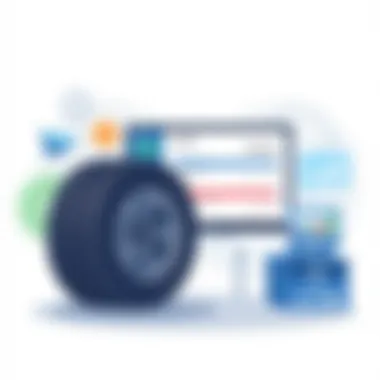Tire Shop Invoice Software: Key Features and Benefits


Intro
In the bustling world of tire retail, efficiency and accuracy are paramount. Tire shop invoice software has emerged as a crucial tool to ensure smooth operations and meticulous financial management. This article looks closely at the integral role such software plays, particularly how it streamlines invoicing processes and boosts overall operational productivity. We’ll uncover various features, benefits, and the pivotal reasons for transitioning to digital systems that fuel today’s tire shops.
Switching from paper invoicing to a well-designed software solution makes a world of difference. It’s not just about saving trees; it’s about reclaiming time for service, which is the lifeblood of any tire business. The modern landscape of tire retail demands agility, and software developers have taken heed.
Dive in as we explore the nuances of tire shop invoice software, ensuring that business owners and managers grasp everything from selection criteria to a detailed analysis of leading software solutions in the market.
Software Category Overview
Purpose and Importance
Tire shop invoice software serves as the backbone of financial transactions within tire retailers. The primary purpose is to manage invoicing seamlessly while reducing errors that often accompany manual processes. This software is not just about creating and sending invoices; it simplifies tracking sales, monitoring inventory, and generating financial reports.
The importance of this software can’t be overstated. Here are some key reasons:
- Increased Efficiency: Automating invoice creation can save hours each week.
- Enhanced Accuracy: Minimized human error leads to less financial discrepancies.
- Better Cash Flow Management: Understanding your cash flow can make a significant difference to your tire business's health.
Current Trends in the Software Category
Modern tire shop invoice software has evolved remarkably, integrating features that adapt to the fast-paced market dynamics. Some current trends include:
- Cloud-Based Solutions: Allowing accessibility from anywhere, which is essential for tire shops with multiple locations.
- Mobile Applications: Many retailers seek solutions that fit into their mobile lifestyle, enabling invoicing on-the-go.
- Integration with Other Technologies: Such as point-of-sale systems and customer relationship management tools, providing a unified operational platform.
This blend of functionality not only boosts productivity but also enhances customer satisfaction—an often overlooked aspect in retail settings. Historically, paper invoices or basic Excel sheets did the job, but in today’s tech-savvy environment, that approach can hold a business back.
Data-Driven Analysis
Metrics and Criteria for Evaluation
Selecting the proper tire shop invoice software can be daunting given the plethora of options available. Business leaders must focus on key metrics and criteria such as:
- User Experience: Is the interface intuitive for staff?
- Scalability: Can the software grow with your business needs?
- Customer Support: What kind of support is offered post-purchase?
These metrics help ensure that the chosen software not only meets current demands but is also flexible enough to evolve with changing business landscapes.
Comparative Data on Leading Software Solutions
With software options growing, it’s essential to conduct a comparative analysis. Here’s a look at some of the top solutions available:
- TirePro
- Shop-Ware
- QuickBooks
- Strengths: Comprehensive inventory management, user-friendly interface.
- Ideal for: Medium to large tire retailers.
- Strengths: Strong customer relationship management capabilities.
- Ideal for: Shops needing detailed customer engagement.
- Strengths: Excellent financial tracking features.
- Ideal for: Businesses already using QuickBooks for bookkeeping.
"Investing in the right tire shop invoice software means choosing a tool that not only meets immediate needs but also anticipates future growth opportunities."
The right choice tailors to the specific workflows and demands of any tire shop, ensuring minimal disruption and maximal efficiency.
As the tire industry continues to grow, strategically implementing invoice software represents not just a change in operations but a step toward sustainable business practices. The journey toward improved efficiency and financial clarity can start simply by understanding these tools and their potentials.
Understanding Tire Shop Invoice Software
In the realm of tire retail, the intricacies of managing financial transactions can often feel like a labyrinth. This is precisely where tire shop invoice software steps in, serving as a beacon of efficiency for business owners and their teams. Understanding this type of software is paramount because it has the potential to transform the invoicing landscape of tire shops, enabling quicker operations and fortifying financial management.
Definition and Purpose
Tire shop invoice software is a specialized tool designed to facilitate the creation, management, and tracking of invoices related to tire sales and services. Its primary purpose lies in streamlining invoicing processes, reducing the time and effort required for manual invoices, and minimizing human error. By providing a centralized platform, it allows tire shop owners to easily manage customer accounts, track sales, and ensure that the billing process is smooth and accurate.
The significance of this software extends beyond just generating invoices. It unifies various elements of tire shop operations, integrating sales tracking, customer interactions, and payment processing into one cohesive system. This not only enhances productivity but also improves financial accuracy and ultimately contributes to the profitability of the business.
Key Components of Invoice Software
A solid invoicing solution encompasses several crucial components that ensure its effectiveness and usability within a tire shop environment. Here are the key elements that can determine the success of such software:
User Interface Design
The user interface (UI) design of tire shop invoice software is critical, as it directly affects user interaction and satisfaction. A well-thought-out UI provides intuitive navigation, making it easier for employees to find what they need without a steep learning curve.
One of the standout characteristics of effective UI design is clarity. This means presenting information in a visually understandable manner, often through clean layouts and logical workflows. Such features are beneficial because they encourage user engagement and minimize training time.
A unique aspect of superior UI design is responsiveness. This allows the software to adapt to various devices, from desktops to tablets, making it accessible on the go. The advantage here is that employees can access invoicing tools wherever they are, facilitating timely billing and communication.
Invoice Generation Templates


Invoice generation templates are another vital component that allows businesses to create invoices quickly and efficiently. Templates can often be customized to reflect the branding of the tire shop, which adds a professional touch to the invoices sent to customers.
The noteworthy aspect of these templates is flexibility. They enable users to include variable details, such as customer information, itemized lists of tires and services, and tax calculations, simplifying the billing process significantly. Many tire shop invoice software solutions provide multiple template options, catering to different preferences in layout and information Display.
However, one disadvantage to consider is that overly complex templates can lead to confusion. A focus on simplicity helps maintain clarity, ensuring that the intended message is communicated effectively, without overwhelming the customer with unnecessary information.
Payment Processing Integrations
Payment processing integrations are a game changer in terms of simplifying the payment collection process. These integrations enable tire shops to accept various payment methods, including credit cards, digital wallets, and even cryptocurrencies, catering to a wider customer base.
A key characteristic of robust payment processing integrations is security. This is essential as financial transactions are sensitive in nature. Choosing software with strong encryption and compliance with standards like PCI DSS can protect both the business and its customers from potential fraud.
One unique feature found in some software solutions is the automatic reconciling of payments against invoices. This can save considerable time and effort for employees, enabling them to focus on customer service and other critical areas of the business. The downside, however, is that businesses need to ensure that the integration works seamlessly with their existing financial systems, as any hiccup can lead to confusion and misinformation in accounting records.
In summary, understanding tire shop invoice software means recognizing its multi-faceted nature and the roles its components play. A blend of user-friendly design, adaptable templates, and secure payment options can significantly elevate operational efficiency and financial management in tire retail.
Importance of Invoice Software in Tire Retail
In the fast-paced world of tire retail, the efficiency of billing processes significantly affects overall business health. Utilizing invoice software is no longer a luxury; it’s a necessity. This software ensures accuracy, speed, and professionalism, allowing tire shop owners and managers to focus more on serving customers rather than getting lost in paperwork. By streamlining invoicing tasks, it stands as a backbone of modern financial practices in tire retail.
Impact on Financial Management
Managing finances can often feel like a juggling act, especially for those in tire retail, where margins can be tighter than a drum. Invoice software is pivotal in enhancing financial management by automating tedious tasks. Seamless invoice generation keeps records organized, which helps in tracking payments, monitoring outstanding balances, and managing cash flow effectively.
Consider the scenario of a bustling tire shop where invoices are created manually. Errors in human input not only lead to customer dissatisfaction but can also cause losses when billing amounts are incorrectly calculated. Invoice software minimizes these manual errors by providing templates that ensure uniformity and correctness.
Some features to consider for effective financial management include:
- Automated reminders for overdue invoices
- Real-time tracking of payments
- Detailed financial reports that help in understanding the cash flow
These elements contribute to a clearer financial picture, aiding tire retailers in making informed decisions.
Enhancing Customer Experience
The customer experience is the lifeblood of any retail business. In tire shops, customer satisfaction often hinges on the efficiency and clarity of the service provided. Invoice software enhances the customer experience by simplifying the payment process. Instead of dealing with cumbersome paperwork, customers can receive invoices via email or through an application. This not only accelerates payment cycles but can also increase trust and transparency between the shop and the customer.
Imagine walking into a tire shop where you quickly describe your needs and leave with a professionally drafted invoice in your email. It improves the perception of the business as one that values its customers’ time. Furthermore, invoice software often enables customers to pay directly online, which adds another layer of convenience.
Some key improvements to customer experience via invoice software include:
- Instant receipts, eliminating waiting times
- Clear breakdown of services and charges to avoid misunderstandings
- Enhanced communication through integrated messaging features
Streamlining Operations
In any retail setting, time is money. Manual invoicing processes can cause significant slowdowns, hindering operations and customer flow. Tire shop invoice software introduces a level of automation that not only saves time but also enhances overall efficiency.
For instance, the ability to track inventory alongside invoicing ensures that the shop doesn’t sell tires they don’t have in stock. This integration of systems reduces the risk of errors and miscommunication across teams. Additionally, features like digital signatures and workflow automation streamline approvals and revisions, cutting down on time spent on administrative tasks.
Key operational benefits of invoice software:
- Integration with inventory management systems to keep stock in check
- Efficient storage and retrieval of invoices for easy access
- Capability to handle multiple payment methods seamlessly
These tools together create a more agile business environment which, in turn, boosts performance.
"Embracing technology like invoice software can transform the operational landscape of tire retail, turning cumbersome tasks into smooth processes."
Features to Look for in Tire Shop Invoice Software
In the realm of tire retail, selecting the right invoice software can make or break efficiency. As tire shop owners grapple with various operational tasks, an ideal invoicing tool can simplify these complex processes, turning a monumental workload into manageable jobs. The features of the software directly influence financial accuracy, customer experience, and day-to-day operations. Here, we’ll examine key features that one should consider when scouting for tire shop invoice software.
Customization Options
Customization is the name of the game when it comes to invoice software. Different shops have varying needs based on their customer demographics and service offerings. A customizable invoicing solution allows tire shops to tailor their invoices according to the branding requirements.
Imagine a tire shop that sells both high-end and budget tires. They might want to segment invoices based on customer types, highlighting promotions for specific groups while maintaining a professional look. Customization ensures that the software adapts to the shop rather than the shop adapting to the software. Furthermore, the ability to modify templates and add personalized notes can bolster customer relationships, showcasing a professional touch.
Reporting and Analytics
Reporting tools bundled within invoicing software can be a treasure chest of insights. They provide crucial visibility into financial health, operational efficiencies, and customer purchasing patterns. This feature allows shop owners to discern whether certain products are flying off the shelves or if there are pockets of wastage that need addressing.
For instance, the software's analytics capabilities might show a steady increase in sales of off-road tires during specific months. This information could help in planning inventory better, enhancing promotional efforts, or keeping an eye on trends in tire demand. This granularity allows tire shop owners not just to react, but to strategically plan their business moves.
Integration Capabilities
Integration is fundamental in a modern business environment. The ability for invoicing software to integrate with other tools magnifies its utility.
Accounting Software


One prominent integration to consider is with accounting software like QuickBooks or Xero. This integration streamlines financial reporting and ensures that all transactions are recorded effortlessly. The smooth flow of data between invoicing and accounting reduces the chance for manual errors—an essential factor for maintaining financial integrity.
Using such accounting software not only expedites the reconciliation process but also provides timely insights into financial standing. A user can generate comprehensive financial reports with just a few clicks, allowing for real-time decision-making and smoother year-end audits.
Inventory Management Systems
Effective inventory management is another crucial aspect that benefits from integration with invoicing software. This ensures that stock levels are continuously updated as orders are invoiced. A clear picture of inventory levels helps gear up for busy seasons and avoids overstocking or understocking scenarios.
For instance, if a popular tire model is selling like hotcakes, integration facilitates reordering quickly, keeping the shelves stocked when customer demand peaks. This capability acts as a safety net for tire shops, enabling them to provide excellent service without the hiccups of stockouts.
Comparing Leading Invoice Software Options
In the world of tire retail, the choice of invoice software can play a pivotal role in shaping the efficiency and effectiveness of daily operations. As tire shops seek to optimize their processes and increase profitability, comparing leading invoice software options emerges as a fundamental activity. This comparison not only allows businesses to understand the landscape of available tools but also highlights specific functionalities that can cater to the unique needs of tire retailers. When scrutinizing various software solutions, factors such as user-friendliness, feature richness, and cost effectiveness come to the forefront. Having the right software means fewer headaches down the road and streamlining invoicing processes, celebrating the positive impacts on the bottom line.
Overview of Popular Solutions
Amid the myriad options in the market, several invoice software solutions have gained a reputation for their robustness and reliability. For instance, QuickBooks stands out for its comprehensive financial management capabilities, while FreshBooks offers intuitive invoicing features that cater well to small businesses. Moreover, Tire Shop Pro is tailored specifically for tire retailers, integrating inventory management seamlessly with invoicing. Each of these platforms brings something unique to the table:
- QuickBooks: Best for businesses looking for a full-fledged accounting solution.
- FreshBooks: Ideal for those who prioritize user experience and simplicity.
- Tire Shop Pro: Focused on tire shops, aiding in inventory and customer management simultaneously.
- Square Invoices: Excellent for mobile invoicing and easy payment processing.
This diverse array of solutions allows tire retailers to explore options that align with specific business requirements. Understanding these popular solutions helps shop owners not just to find a suitable option, but to position their shops for greater success.
Feature Comparison
When assessing invoice software, the features provided will determine the software's overall utility. Below is a comparative look into some noteworthy features common among leading invoice software options:
- Customization: The ability to create tailored invoices that mirror branding is crucial. QuickBooks, for instance, provides numerous templates that can be tailored to fit a shop's identity.
- Data Integration: Many software solutions allow integration with other business systems, such as Point of Sale systems or e-commerce platforms. These integrations save time and reduce the likelihood of errors in manual data entry.
- User Interface: A clean, intuitive interface can make all the difference. Users prefer a platform that doesn’t require a steep learning curve, a feature where FreshBooks shines.
- Reporting Tools: Insightful analytics and reporting capabilities enable tire shop owners to glean valuable insights from their invoicing data. This fosters better decision-making in inventory management and customer engagement.
By breaking down these features, businesses can align their needs with the strengths of different invoice solutions. Not every feature will be necessary for all tire shops, but those seeking significant efficiencies should look closely at them.
Cost Analysis
Cost is a significant factor when comparing invoice software. While some solutions come with a hefty price tag, others offer competitive pricing that may provide high value for money. Here’s a closer look at how costs can vary:
- Subscription Models: Many platforms operate on monthly or annual subscriptions. For instance, FreshBooks can start at around $15 per month, making it an accessible choice for smaller tire retailers.
- Setup Fees: Some software solutions may charge one-time setup fees that can hit hard, especially for shops just starting out. It's essential to inquire about this before making a decision.
- Hidden Costs: While much is made about upfront software costs, understanding potential hidden costs—such as transaction fees, customer support charges, or costs linked to additional features—will give a complete picture.
- Return on Investment: Ultimately, investing in high-quality software should lead to increased operational efficiency and reduced overhead costs, thereby reflecting positively on the overall financial strategy of the tire shop.
In summary, conducting a thorough cost analysis helps businesses avoid financial pitfalls while ensuring they are making an informed decision in selecting the right software for their needs. Such diligence can pave the way for more effective management of invoicing processes, ultimately contributing to the shop's success.
By weighing these factors and taking a closer look at the various features and costs, shop owners can make informed decisions, ensuring their investment aligns with their business objectives and growth strategies.
Benefits of Digitizing Invoicing Processes
Opting for digital invoicing solutions in tire shops has become a key strategy for success, molding how businesses approach financial management. A shift from traditional paper-based invoicing to modern digital systems can streamline not only operational tasks but also refine financial accuracy. By focusing on three primary advantages—reducing manual errors, improving cash flow management, and enhancing accessibility and collaboration—this overview sheds light on the benefits of digitizing invoices.
Reduced Manual Errors
One of the primary reasons businesses are moving towards digital invoicing solutions is the significant reduction in manual errors. When relying on handwritten or manually typed invoices, the chance of mistakes escalates. Incorrect data can lead to incorrect billing, not to mention potential disputes with customers. Digital systems often come equipped with features like:
- Automated calculations - This minimizes human errors in number crunching, ensuring accuracy in totals and taxes.
- Templates - Pre-designed invoice formats help in standardizing the information presented, so businesses don’t miss critical details.
- Validation checks - Many software solutions incorporate checks that alert users to inconsistent or missing information.
By drastically cutting down on these mistakes, tire shops can assure customers of accurate billing, fostering trust and credibility in their service. This proactive approach to error reduction ultimately saves time and effort in addressing disputes and corrections.
Improved Cash Flow Management
Cash flow is the lifeblood of any business, and managing it effectively is critical for tire retailers. Digital invoicing systems can enhance financial flows significantly. Here are some ways they contribute:
- Faster invoice processing - Time is money. Digital solutions allow for quick generation and dispatch of invoices, getting requests for payment out the door in record time.
- Automatic payment reminders - Reminder mechanisms integrated into invoicing software ensure that overdue payments don’t slip through the cracks, prompting timely follow-ups.
- Tracking unpaid invoices easily - Users can generate reports that give visibility into outstanding payments, enabling better cash flow predictions and planning for future expenditures.
This smooth management of cash flow reduces the stress associated with payment cycles and enhances overall business resilience in a competitive market.
Enhanced Accessibility and Collaboration
In today’s fast-paced world, accessibility and collaboration are more important than ever. Digital invoicing brings these elements to the forefront.
- Cloud-based solutions - By utilizing cloud technology, users can access invoices from anywhere, be it at the shop or on the go. This flexibility can be a game-changer for tire shop owners and employees alike, allowing for efficiency regardless of physical location.
- Multi-user access - Many systems enable multiple users to collaborate on invoices, ensuring that individuals in different roles can contribute and share insights. This collaborative feature enhances teamwork and accountability between staff.
- Integrated communication tools - Some invoice software includes messaging functionalities, allowing stakeholders to discuss specifics directly within the platform, reducing the need for external communications.
Ultimately, embarking on a journey towards digital invoicing not only boosts efficiency but also cultivates a culture of teamwork and transparency among employees, propelling the organization towards its vision.
"Digital invoicing isn't just about efficiency; it's about reshaping the entire financial landscape of your business for better navigation and accountability."
As tire shops continue to evolve, embracing these benefits can provide a substantial competitive advantage, ensuring that they stay not just afloat but thriving in a rapidly changing market.
Transitioning to Tire Shop Invoice Software
Making the switch to tire shop invoice software is a pivotal move for any tire retailer looking to modernize their operations and enhance efficiency. In today's fast-paced business environment, relying on traditional paper invoicing or outdated digital solutions can hinder your profitability and customer satisfaction. Transitioning to a specialized invoicing software brings forth numerous benefits that streamline operations, reduce errors, and ultimately save time and money.


The decision to adopt such software goes beyond just upgrading a tool; it defines how businesses manage their financial processes. Invoice software not only automates routine tasks, it also provides deeper insights into finances through robust reporting features. This knowledge allows for better strategic decisions that can contribute to business growth and sustainability.
Steps for Successful Implementation
Implementing tire shop invoice software requires a structured approach. Starting with a clear plan helps ensure that all aspects are taken into account. Here are some key steps:
- Identify Requirements: Assess the specific needs of your shop. What features are most critical? Consider aspects like ease of use, integration with other systems, and specific reporting needs.
- Choose the Right Software: Research and compare different software options. Look for reviews and case studies that illustrate how others have benefited from similar solutions.
- Prepare Your Data: Often, companies face challenges related to the existing data. Clean up current customer lists, product inventories, and historical invoices to prepare them for import.
- Set Up the System: Work through the software’s setup process, often requiring configurations to suit your shop’s requirements. Ensure all key functionalities are enabled and tailored accordingly.
- Test the System: Run several test scenarios before fully deploying the software. This helps to catch any potential issues early and assures that it meets your expectations.
Training Staff and Users
Equipping your staff with the necessary skills to utilize the invoicing software is crucial. The best technology in the world won't yield results if the users are not proficient in it. Effective training is multifaceted:
- Conduct Workshops: Organize hands-on workshops to familiarize staff with various features, especially highlighting the ease of generating invoices and reports.
- Create Helpful Guides: Develop user manuals or quick-reference guides that staff can consult post-training. This makes it easier for them to recall information when using the software.
- Establish Support Channels: Ensure there’s ongoing support, such as a dedicated team or a hotline, so that users can reach out whenever issues arise during their routine tasks.
“Investing time in training might seem tedious now, but it pays off tenfold when dealing with day-to-day tasks.”
Migration of Existing Invoices
Shifting to a new invoice system also means addressing how to handle existing invoices. Migration is central to preserving historical data and maintaining continuity. Here’s how it can be managed:
- Backup Old Data: Before attempting any migration, back up your existing data to prevent any losses during transition.
- Use Import Features: Most modern invoice software includes features to import existing invoices in bulk. Follow the guidelines provided by the software to ensure accuracy.
- Validate After Migration: After completing the migration, it's critical to verify that all data has transferred correctly. Check a sample of the invoices to confirm that they align with your previous records.
Adopting tire shop invoice software isn’t merely about keeping pace with technology; it’s a strategic decision that builds a foundation for enhanced financial accuracy and operational efficiency. Making the move thoughtfully ensures your business will not only survive but thrive in a competitive landscape.
Challenges in Invoice Management
Managing invoices is a critical yet often cumbersome aspect of running a tire shop. As operations scale and transactions multiply, the intricacies of invoice management can quickly become a headache for business owners. Recognizing the challenges associated with invoicing allows tire retailers to strategize and implement solutions effectively.
Common Issues Faced
Invoice management in tire shops often encounters a range of issues that can affect efficiency and accuracy. The following are common problems:
- Data Entry Errors: Manual data entry is prone to mistakes. Simple typos can lead to inaccuracies, affecting both customer satisfaction and financial reporting.
- Inadequate Tracking: Without a robust system, tracking unpaid invoices can become a daunting task. Some shops may find themselves needing to chase payments for too long, disrupting cash flow.
- Complex Formatting: Generating invoices that meet both business and client requirements can be complicated, particularly when trying to maintain a professional appearance.
- Integration Issues: Many tire shops utilize different systems for various functions. Incompatibilities between invoice software and accounting systems can create further complications, leading to fragmented financial data.
- Limited Reporting: Some users may find their current invoice management tool lacks the reporting capabilities necessary to monitor trends and payment histories effectively.
These issues not only slow down the invoicing process but can also have broader implications for a tire shop's financial health. The inability to manage invoices efficiently can hinder growth and impact customer relationships.
Solutions and Best Practices
To navigate these challenges, tire shop owners should consider integrating best practices tailored for effective invoice management. Here are several solutions:
- Adopt Automated Invoice Software: Investing in specialized invoice software designed for tire shops mitigates manual data entry errors while streamlining the invoicing process. Solutions like QuickBooks and FreshBooks can automate many repetitive tasks.
- Implement Centralized Tracking Systems: Utilize tools with features that allow complete visibility of outstanding invoices. This keeps a clear pipeline for cash flow and aids in timely follow-ups.
- Standardize Invoice Formats: Developing a consistent invoice template can save time and reduce errors in formatting. Ensure all necessary fields like the customer’s details, tire service descriptions, and pricing are clearly defined.
- Focus on Integration: Choose software that seamlessly integrates with existing accounting and inventory systems. This harmony not only streamlines operations but also minimizes discrepancies across platforms.
- Leverage Reporting Tools: Look for software that provides advanced reporting features. These tools can track unpaid bills, identify payment patterns, and assist in forecasting cash flow, allowing for informed decision-making.
"A stitch in time saves nine"—addressing invoicing woes early can save tire shops from future complications.
When tire shop owners proactively tackle these challenges with forward-thinking strategies, they set themselves up for smoother operations and better financial health. Improving invoicing isn't just a minor fix; it's a foundational element that can propel a business toward lasting success.
Future Trends in Invoice Software for Tire Shops
As technology continues to evolve, tire shops must keep pace with emerging trends in invoicing software. The implications of these shifts can significantly impact operations, customer engagement, and financial management. Understanding the future trends in invoice software is crucial for tire retailers as they navigate the landscape of digital transformation. Companies that stay ahead of the curve can leverage these advancements to boost efficiency and enhance the customer experience.
Integration of Artificial Intelligence
Invoicing software powered by artificial intelligence (AI) is set to revolutionize the tire retail industry. AI's ability to process vast amounts of data means that invoice management can become more intuitive and automated. Features such as automated data entry can help eliminate tedious tasks that often drain time and resources.
For example, imagine a system where once a customer makes a purchase, the software automatically generates an invoice, applies the correct taxes, and sends a digital receipt to the customer. This not only minimizes human error but also speeds up the entire process from sale to invoice delivery.
Furthermore, AI can analyze purchasing patterns and predict inventory needs. This predictive capability can assist shops in managing their stock more efficiently, ensuring they have the right tires available when customers come calling. With such powerful tools at their fingertips, tire shops can maintain competitive advantages and deliver exceptional service.
Growing Importance of Mobile Solutions
Mobile solutions for invoicing are gaining traction, driven by the increasing reliance on smartphones and tablets in business operations. The ability to manage invoicing processes through mobile devices allows tire shop owners and employees to work anywhere. Imagine a technician on the go, at a client’s location, able to generate and send an invoice immediately after service. This leads to quicker cash flow and enhanced customer satisfaction.
The trend toward mobile invoicing means tire retailers need to consider software that offers robust mobile applications. These applications should be user-friendly, enabling staff to access information quickly and execute tasks efficiently while out of the office. Some critical aspects to consider include:
- Accessibility: Can users access the invoice software from their mobile devices easily?
- Functionality: Does it support all necessary features like invoicing, reporting, and payment processing on mobile?
- Security: Are sensitive customer and financial data adequately protected in the mobile environment?
Ending
In the realm of tire retail, invoice management often dwells in the shadows while daily operations bustle. Yet, the significance of choosing the right invoice software cannot be dismissed. The final thoughts on this topic weave together the elements discussed, highlighting how a well-selected software solution can streamline processing and boost profitability.
Recap of Key Takeaways
When considering tire shop invoice software, the following points resonate:
- Efficiency Redefined: A dedicated invoice software can substantially reduce time spent on billing processes. No more wrangling with spreadsheets. Instead, tailor-made invoices can be generated in mere clicks, allowing staff to focus on customer service.
- Accuracy is Key: Digital invoicing virtually eliminates the errors commonly seen in manual input. Minimizing disputes over billing can foster stronger relationships with clients.
- Real-time Insights: Modern invoice systems often come with reporting features. This provides shop owners with valuable insights concerning sales trends and cash flow, facilitating better financial decision-making.
- Integration Power: Look for options that can play nice with existing tools, such as accounting platforms or inventory trackers. A cohesive ecosystem simplifies the overall workflow.
Final Thoughts on Software Selection
Choosing the right invoicing software is not just about ticking boxes. It requires a deep dive into the unique needs of your tire shop. Factors like:
- User Experience: A clean, intuitive interface will save time during training and use.
- Scalability: Think about the future. Will your software evolve alongside your business, accommodating growth without a hitch?
- Support Systems: Evaluate what customer support looks like. A responsive help desk can save headaches when issues arise.
Ultimately, the goal is to enhance operational efficiency while boosting customer satisfaction. By aligning your needs with the right tools, tire shops can embark on a transformative journey towards smarter business management. This article serves just as the initiation of a deeper understanding of the tools available; the real gains come from practical application and ongoing refinement.







